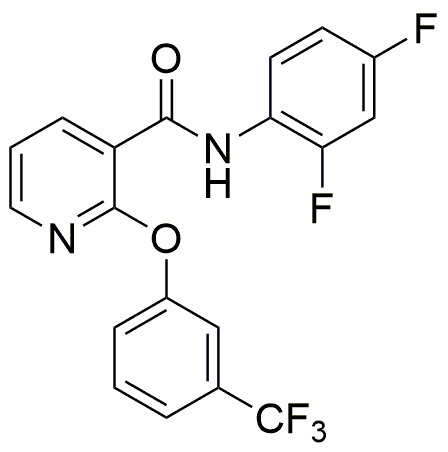Diflufenican is widely utilized in research focused on:
- Agricultural Herbicide: It is primarily used as a selective herbicide in various crops, effectively controlling a wide range of broadleaf weeds while minimizing damage to cereal crops.
- Environmental Studies: Researchers employ diflufenican to study its environmental impact and behavior in soil and water, helping to assess its safety and efficacy in agricultural practices.
- Pesticide Formulations: It serves as a key ingredient in pesticide formulations, providing enhanced weed control compared to traditional herbicides, which can lead to improved crop yields.
- Resistance Management: The chemical is used in developing integrated weed management strategies, helping to combat herbicide-resistant weed populations effectively.
- Research on Plant Physiology: Scientists utilize diflufenican to investigate its effects on plant growth and development, contributing to a better understanding of plant responses to herbicides.
General Information
Properties
Safety and Regulations
Applications
Diflufenican is widely utilized in research focused on:
- Agricultural Herbicide: It is primarily used as a selective herbicide in various crops, effectively controlling a wide range of broadleaf weeds while minimizing damage to cereal crops.
- Environmental Studies: Researchers employ diflufenican to study its environmental impact and behavior in soil and water, helping to assess its safety and efficacy in agricultural practices.
- Pesticide Formulations: It serves as a key ingredient in pesticide formulations, providing enhanced weed control compared to traditional herbicides, which can lead to improved crop yields.
- Resistance Management: The chemical is used in developing integrated weed management strategies, helping to combat herbicide-resistant weed populations effectively.
- Research on Plant Physiology: Scientists utilize diflufenican to investigate its effects on plant growth and development, contributing to a better understanding of plant responses to herbicides.
Documents
Safety Data Sheets (SDS)
The SDS provides comprehensive safety information on handling, storage, and disposal of the product.
Product Specification (PS)
The PS provides a comprehensive breakdown of the product’s properties, including chemical composition, physical state, purity, and storage requirements. It also details acceptable quality ranges and the product's intended applications.
Certificates of Analysis (COA)
Search for Certificates of Analysis (COA) by entering the products Lot Number. Lot and Batch Numbers can be found on a product’s label following the words ‘Lot’ or ‘Batch’.
*Catalog Number
*Lot Number
Certificates Of Origin (COO)
This COO confirms the country where the product was manufactured, and also details the materials and components used in it and whether it is derived from natural, synthetic, or other specific sources. This certificate may be required for customs, trade, and regulatory compliance.
*Catalog Number
*Lot Number
Safety Data Sheets (SDS)
The SDS provides comprehensive safety information on handling, storage, and disposal of the product.
DownloadProduct Specification (PS)
The PS provides a comprehensive breakdown of the product’s properties, including chemical composition, physical state, purity, and storage requirements. It also details acceptable quality ranges and the product's intended applications.
DownloadCertificates of Analysis (COA)
Search for Certificates of Analysis (COA) by entering the products Lot Number. Lot and Batch Numbers can be found on a product’s label following the words ‘Lot’ or ‘Batch’.
*Catalog Number
*Lot Number
Certificates Of Origin (COO)
This COO confirms the country where the product was manufactured, and also details the materials and components used in it and whether it is derived from natural, synthetic, or other specific sources. This certificate may be required for customs, trade, and regulatory compliance.


